Analysis of the Feasibility of Cats and Hamsters Coexisting
Whether cats and hamsters can live in harmony depends on breed temperament, care management, and environmental design. The following factors need to be comprehensively evaluated:

1. Cat Acceptance and Associated Risks
Predatory Instinct: Cats are naturally inclined to view small rodents as prey, and hamsters may trigger their hunting behavior.
Temperament Differences: Kittens (2–9 weeks old) that are exposed to hamsters from a young age may have reduced aggression. However, adult cats or high-energy breeds (e.g., Siamese cats) pose a higher risk.
2. Survival Stress for Hamsters
Stress Responses: Hamsters are timid and easily frightened. The presence of a cat can cause them long-term anxiety, and may even lead to health issues.
Safety Needs: A fully enclosed metal cage (to prevent cat claws from breaking in) and an elevated hiding space must be provided to avoid direct contact between the two.
3. Key Conditions for Successful Coexistence
Phased Adaptation: First, let the cat get familiar with the hamster’s scent (e.g., by swapping their bedding), then gradually introduce visual contact.
Strict Supervision: When the two are in the same space, constant supervision is required. Promptly stop any pouncing or grabbing behavior from the cat.
Resource Allocation: Ensure the hamster has an independent activity area to avoid competition over food or territory.
Reference to Real-World Cases
Successful Cases: In some households, long-term training has enabled cats and hamsters to "live their own lives" without conflict. However, this requires a high level of commitment from the owner.
Failure Risks: Improper management may cause hamsters to stop eating due to fear, suffer injuries, or even be accidentally killed by the cat.
Conclusion: Active Attempts Are Not Recommended
If coexistence is unavoidable, strict adherence to the above conditions is necessary, and emergency preparations must be in place.
